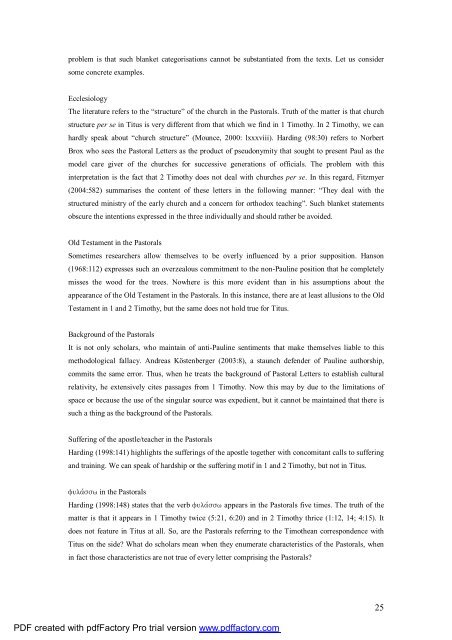A Text centred rhetorical analysis of Paul's Letter to Titus
A Text centred rhetorical analysis of Paul's Letter to Titus
A Text centred rhetorical analysis of Paul's Letter to Titus
Create successful ePaper yourself
Turn your PDF publications into a flip-book with our unique Google optimized e-Paper software.
problem is that such blanket categorisations cannot be substantiated from the texts. Let us consider<br />
some concrete examples.<br />
Ecclesiology<br />
The literature refers <strong>to</strong> the “structure” <strong>of</strong> the church in the Pas<strong>to</strong>rals. Truth <strong>of</strong> the matter is that church<br />
structure per se in <strong>Titus</strong> is very different from that which we find in 1 Timothy. In 2 Timothy, we can<br />
hardly speak about “church structure” (Mounce, 2000: lxxxviii). Harding (98:30) refers <strong>to</strong> Norbert<br />
Brox who sees the Pas<strong>to</strong>ral <strong>Letter</strong>s as the product <strong>of</strong> pseudonymity that sought <strong>to</strong> present Paul as the<br />
model care giver <strong>of</strong> the churches for successive generations <strong>of</strong> <strong>of</strong>ficials. The problem with this<br />
interpretation is the fact that 2 Timothy does not deal with churches per se. In this regard, Fitzmyer<br />
(2004:582) summarises the content <strong>of</strong> these letters in the following manner: “They deal with the<br />
structured ministry <strong>of</strong> the early church and a concern for orthodox teaching”. Such blanket statements<br />
obscure the intentions expressed in the three individually and should rather be avoided.<br />
Old Testament in the Pas<strong>to</strong>rals<br />
Sometimes researchers allow themselves <strong>to</strong> be overly influenced by a prior supposition. Hanson<br />
(1968:112) expresses such an overzealous commitment <strong>to</strong> the non-Pauline position that he completely<br />
misses the wood for the trees. Nowhere is this more evident than in his assumptions about the<br />
appearance <strong>of</strong> the Old Testament in the Pas<strong>to</strong>rals. In this instance, there are at least allusions <strong>to</strong> the Old<br />
Testament in 1 and 2 Timothy, but the same does not hold true for <strong>Titus</strong>.<br />
Background <strong>of</strong> the Pas<strong>to</strong>rals<br />
It is not only scholars, who maintain <strong>of</strong> anti-Pauline sentiments that make themselves liable <strong>to</strong> this<br />
methodological fallacy. Andreas Köstenberger (2003:8), a staunch defender <strong>of</strong> Pauline authorship,<br />
commits the same error. Thus, when he treats the background <strong>of</strong> Pas<strong>to</strong>ral <strong>Letter</strong>s <strong>to</strong> establish cultural<br />
relativity, he extensively cites passages from 1 Timothy. Now this may by due <strong>to</strong> the limitations <strong>of</strong><br />
space or because the use <strong>of</strong> the singular source was expedient, but it cannot be maintained that there is<br />
such a thing as the background <strong>of</strong> the Pas<strong>to</strong>rals.<br />
Suffering <strong>of</strong> the apostle/teacher in the Pas<strong>to</strong>rals<br />
Harding (1998:141) highlights the sufferings <strong>of</strong> the apostle <strong>to</strong>gether with concomitant calls <strong>to</strong> suffering<br />
and training. We can speak <strong>of</strong> hardship or the suffering motif in 1 and 2 Timothy, but not in <strong>Titus</strong>.<br />
fulavssw in the Pas<strong>to</strong>rals<br />
Harding (1998:148) states that the verb fulavssw appears in the Pas<strong>to</strong>rals five times. The truth <strong>of</strong> the<br />
matter is that it appears in 1 Timothy twice (5:21, 6:20) and in 2 Timothy thrice (1:12, 14; 4:15). It<br />
does not feature in <strong>Titus</strong> at all. So, are the Pas<strong>to</strong>rals referring <strong>to</strong> the Timothean correspondence with<br />
<strong>Titus</strong> on the side? What do scholars mean when they enumerate characteristics <strong>of</strong> the Pas<strong>to</strong>rals, when<br />
in fact those characteristics are not true <strong>of</strong> every letter comprising the Pas<strong>to</strong>rals?<br />
PDF created with pdfFac<strong>to</strong>ry Pro trial version www.pdffac<strong>to</strong>ry.com<br />
25

















